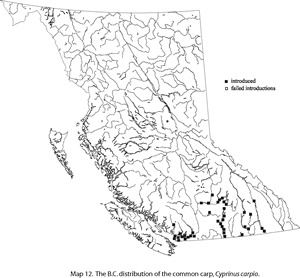Dorsal spines (total): 3 - 4; Dorsal soft rays (total): 17 - 23; Anal spines: 2 - 3; Anal soft rays: 5 - 6; Vertebrae: 36 - 37. Pharyngeal teeth 1, 1, 3:3, 1,1, robust, molar-like with crown flattened or somewhat furrowed. Scales large and thick. `Wild carp ' is generally distinguished by its less stocky build with height of body 1:3.2-4.8 in standard length. Very variable in form, proportions, squamation, development of fins, and color. Caudal fin with 3 spines and 17-19 rays (Ref. 2196). Last simple anal ray bony and serrated posteriorly; 4 barbels; 17-20 branched dorsal rays; body grey to bronze (Ref. 43281). Also Ref. 3398, 3410.
Source: FishBase. Kottelat, M. 1997 European freshwater fishes. Biologia 52, Suppl. 5:1-271.
